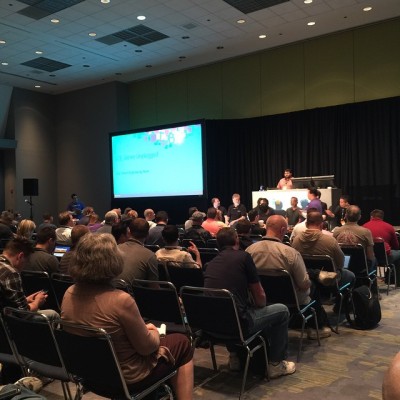This afternoon, we had one of my favorite sessions: the off-the-cuff Q&A with some of Microsoft’s best and brightest. I probably missed somebody, but for sure we had Conor Cunningham, Joe Yong, Jos de Bruijn, Kevin Farlee, Luis Carlos Varga Herring, Mike Weiner, Sunil Agarwal, and Tiffany Wissner.
Hubba hubba.

These sessions are fun to attend because sometimes you can get hints and details that weren’t originally scheduled to go public.
I didn’t transcribe all of the questions – often the answers are well-known amongst smart people like you, dear reader. You’re also attractive too, but I digress.
Q: How do you control engine versioning in Azure SQL Database?
Conor answered: SQL Azure is platform-as-a-service (PaaS). It gets you automatic patching. We build SQL Azure and SQL Server off the same mainline branch of code, and we ship first in SQL Azure. We can turn them on for limited sets of accounts first, then turn it on more broadly in public preview mode, and then eventually make it generally available. We have a whole fabric layer used to manage our versions and deploy them as we need it. You’re getting the next version of SQL Server before it ships to the public.
Followup Q: Can you use a database compatibility level to control the version you’re on?
Conor answered: In January, we launched the new round of v12 servers. Before v12, we didn’t expose compatibility level settings. Now, we’re starting to expose the 130 compatibility level, which will also be the compatibility level in SQL Server 2016. As we get more features aligned to the boxed product, it’ll make more sense.
Q: When I combine AlwaysOn AGs with replication, how do I manage jobs?
Luis answered: you have to manage those manually by copying the jobs to all servers.
Q: Is Always Encrypted going to work with Windows logins?
Conor answered: in the first version, no, but at some point, yes.
Q: What’s the future around DACPACs and deploying a whole app?
Conor answered: Windows Azure has a deployment and servicing model that they’ve been working on, and we’ve been talking about how we can make it work with DACPACs. We don’t have anything to announce today. I’ll be honest with you – there’s a lot of problems with doing this correctly, especially with complex deployments like AlwaysOn AGs.
Q: Besides a single SSDT, are there any other investments in developer tooling or ALM?
Conor answered: We haven’t been doing a ton of major investments there. Anything you’re interested in? (Data generation and automated builds.) There’s some stuff we’ve been working on with the Visual Studio team, but they’re driving it. We don’t have anything to announce in the SQL Server 2016 release time frame though.
Q: I have SQL Server sprawl. How are you helping customers consolidate and move to Azure?
Conor answered with a huge smile: We’ve got the MAPS toolkit, but there’s a couple of things we’re working on that we are working hard on and we can’t share yet.
Luis added: We’re working on making it easier to look at your current database and your AlwaysOn AG configuration, and recommend a set of VMs with the right power in Azure.
Q: In SQL Server 2014, there are a lot of limitations on in-memory OLTP. Is that still true in SQL 2016?
Kevin answered: In 2014, we targeted specific scenarios where we knew we could be successful, and we nailed those. In this release, we’re working on getting it as broad as we can. SQL 2016 will have foreign key constraints between in-memory tables, but not regular tables.
Q: We’re looking at rolling out MDS, but we’re not happy with the current UI. Is Microsoft improving that?
Mike: I’ll have to defer that. (There are no BI experts in this particular session.)
Q: What’s enhanced about the Backup to Azure, and can we get an easier cleanup in maintenance plans?
Luis answered: We deployed it in SQL 2014, and we heard your feedback. We’re now supporting cheaper blob storage and striping (beyond the 1TB limit, up to 32TB). Backup will be parallelized across those stripes, so it’ll be even faster. That will be out in the next CTP. For automated cleanup, consider the managed backup feature rather than maintenance plans.
Q: How will licensing work in SQL Server 2016?
Tiffany answered: We haven’t made those decisions at this point in time. We just went through some significant changes in licensing, and most of our customers are still absorbing that change.
Conor added: You’re asking, is it possible to put all features in all editions? We don’t have anything to announce today. If you look at SQL Azure, it has most of the same features in all editions, and we vary pricing by resources, and that’s something to think about. But we don’t have anything to announce today.
The end – at least of my summary. I had to leave a little early to meet Erika, Jeremiah, and Kendra for dinner. (Gotta love it when conferences happen in my home town.)

